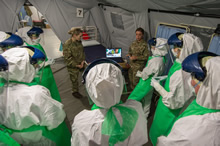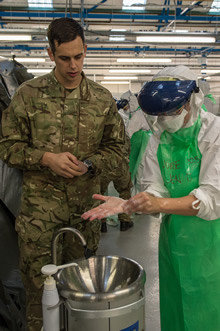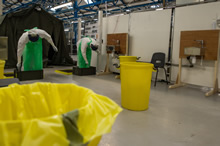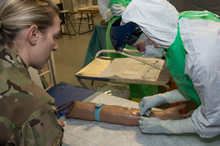Operation SIRONA
Operation SIRONA was the military component of the Canadian whole-of-government contribution to fighting the Ebola outbreak in West Africa. Canadian Armed Forces (CAF) personnel augmented efforts undertaken by the United Kingdom (UK) to combat the spread of the Ebola virus disease (EVD) in Sierra Leone. The mission ended on 30 June 2015.
The Department of Foreign Affairs, Trade, and Development (DFATD) was the departmental lead for Canada’s efforts against Ebola.
The Task Force
Three rotations were carried out and a total of 79 CAF healthcare and support staff were deployed to the UK’s Kerry Town Treatment Unit (KTTU) in Kerry Town, Sierra Leone, located south of the capital city of Freetown.
CAF members worked alongside military partners from the UK to treat local and international healthcare workers who were exposed to the Ebola virus disease.
While in West Africa, CAF members used personal protective equipment and followed safety protocols to mitigate the risk of becoming infected by EVD.
Pre-deployment training
CAF members underwent comprehensive training before their deployment. The first stage of pre-deployment training was conducted at Canadian Forces Base (CFB) Petawawa.
The second stage was conducted with UK personnel at the Army Medical Services Training Centre (AMSTC) in Strensall, UK. This training included:
- lectures by experts in infectious disease (including EVD);
- lectures by healthcare workers with experience working in Sierra Leone;
- cultural awareness training;
- practical scenarios in a simulated EVD treatment centre; and
- a final exercise to confirm the training and that personnel have the necessary skills to operate safely in an Ebola treatment facility.
Mission Context
The 2014 outbreak of the EVD is the deadliest occurrence of the disease since it was discovered in 1976. The World Health Organization (WHO) estimates that more than 27, 500 people have been infected during the outbreak, with more than 11,000 of those cases resulting in fatalities. The magnitude of the outbreak overwhelmed local clinics and healthcare workers.
Liberia, Guinea, and Sierra Leone were the most heavily affected nations. Cases were also confirmed in France, Germany, Italy, Netherlands, Nigeria, Norway, Mali, Senegal, Spain, Switzerland, the UK, and the United States.
Timeline of the outbreak
- December 2013 – A young girl died of the disease in south-eastern Guinea.
- March 2014 – Cases were first reported to Guinea’s Ministry of Health and Médecins sans frontières.
- May 2014 – The disease was confirmed to have crossed Guinea’s border into Liberia and Sierra Leone.
- 8 August 2014 – WHO declared an international public health emergency.
- 18 September 2014 – The UN Security Council conducted its first emergency meeting on a public health crisis and declared the Ebola outbreak a threat to peace and security.
- 19 September 2014 – The UN General Assembly unanimously adopted resolution 69/1 in support of creating the United Nations Mission for Ebola Emergency Response (UNMEER).
Canada’s response
The Government of Canada has committed more than $110 million in health, humanitarian and security contributions to help fight the spread of Ebola, and has also provided in-kind support and donations of the Canadian-developed Ebola vaccine.
Canada is currently monitoring the Ebola outbreak by working with international partners including:
- WHO;
- United States Centers for Disease Control and Prevention; and
- Global Public Health Intelligence Network.
Efforts are being coordinated with the United Nations Mission for Ebola Emergency Response (UNMEER) and through experienced partners within the United Nations system and the International Federation of Red Cross and Red Crescent Societies (IFRC).
Mission timeline
- 3 and 8 October 2014 –RCAF CC-177 Globemaster transports UK personnel and equipment from East Midlands, UK to Freetown, Sierra Leone.
- 27 November 2014 – the Government of Canada announces Operation SIRONA.
- 20 December 2014 – CAF personnel arrive in Sierra Leone.
- 30 December 2014 – CAF Task Force commences operations at the UK’s Kerry Town Treatment Unit in Sierra Leone.
- 20 February 2015 – Second rotation of CAF healthcare personnel arrives in Sierra Leone.
- 6 March 2015 – First rotation of CAF healthcare personnel returns to Canada.
- 20 April 2015 – Third rotation of CAF healthcare personnel arrives in Sierra Leone.
- 8 May 2015 – Second rotation of CAF healthcare personnel returns to Canada.
- 30 June 2015 – the Government of Canada announces the end of Operation SIRONA.
Previous CAF operations in Sierra Leone
Operation SCULPTURE (2000-2013) – Task Force Freetown participated in the International Military Advisory and Training Team, a multinational effort led by Britain to help the Government of the Republic of Sierra Leone build effective and democratically accountable armed forces.
Operation REPTILE (1999-2005) – CAF members deployed as United Nations military observers to the United Nations Mission in Sierra Leone, which was designed to achieve regional peace and stability through disarmament, demobilisation, and the reintegration of forces.
External links
Government of Canada
- Announcement of support to global efforts combatting Ebola (DFATD)
- Canada’s Response to the Ebola Outbreak in West Africa (DFATD)
- Canada’s response to the Ebola outbreak in the West Africa region (Public Health Agency of Canada)
External Links
- Ebola virus disease (World Health Organization)
- United Nations Mission for Ebola Emergency Response
- Médecins sans frontières




